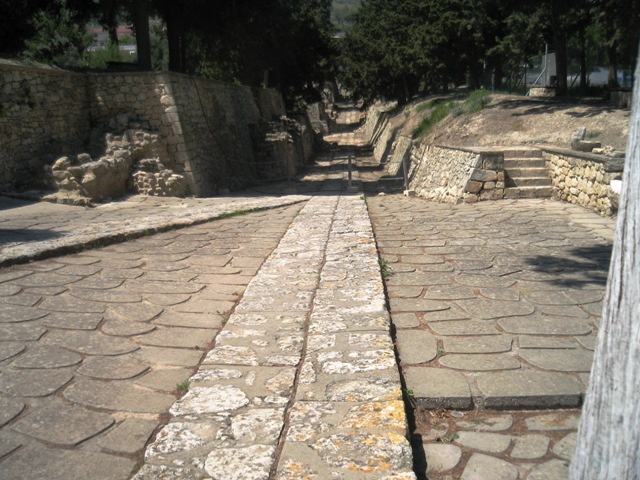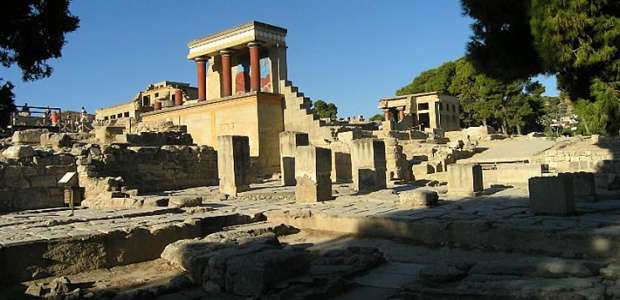The first major Aegean civilization flourished on the Greek island of Crete in 1500 BC. The zenith of its achievements is represented by the spectacular palace complex at Knossos which was excavated and then reconstructed early in the 20th century by a distinguished British archaeologist.
The ancient city of Knossos, about 2 ½ miles (4km) inland from the north shore of Crete, was the centre of one of the great civilizations of the prehistoric Aegean world. According to legend, the palace at Knossos was the home of King Minos and his daughter, Ariadne. When the British archaeologist Arthur Evans was seeking an identifying label for his discoveries, he chose ‘Minoan’ as the name to describe the people who lived at Knossos.

The Minoans seem to have arrived on Crete around 7000 BC, perhaps from Asia Minor (now Turkey). The splendor of their palaces (there was one at Phaistos in the south of the island, and another at Mallia on the north coast) indicates that these people were rich and probably powerful, and the absence of obvious fortification suggests they were also peaceful. The number and the size of the palace storerooms testify to the importance of commerce in Minoan life, as does the network of roadways. Paintings at Knossos in particular a remarkable fresco of an athlete somersaulting over the back of a bull in a mysterious ceremony, vividly depict the perilous sports and rituals for which the city’s inhabitants have become famous.
There is no evidence of bull worship in Minoan culture, but to these people the bull was possible a symbol of virility. Bulls and bull-leaping may also have been the source of the myth of the Minotaur. According to legend, King Minos kept the Minotaur, half man, half bull, in a labyrinth and required Athens, then subject to Minos, to send seven youths and seven maidens every year to be sacrificed to the monster. Theseus, prince of Athens, accompanied the victims to Crete and, helped by King Minos’s daughter, Ariadne, succeeded in killing the Minotaur.

The Minoans built a series of grand palaces towards the end of the third millennium BC, each of which was destroyed by an earthquake and rebuilt on its own ruins. During the following millennium, the growth of Knossos and the spread o Minoan influence were spectacular, culminating in a pinnacle of achievement around 1500 BC. The ruins of the palace of King Minos at Knossos provide outstanding evidence of the artistic, architectural and engineering skills of this island people.
The flowering of Minoan culture was curtailed just over 100 years later when a devastating volcanic eruption on the neighboring island of Santorini reduced Knossos to ruins, resulting in a swift decline in Monoan influence. Not until the beginning of the 20th century did comprehensive archaeological excavations reveal once again the splendor of the ancient palace of Knossos.
The Royal Road links the palace of King Minos with the Little Palace, a notable Minoan building a short distance away from the main palace. Also known as the Professional Way, it is almost certainly the oldest paved road in Europe. It was built between 3000 and 1100 BC.

The palace is a vast construction of private apartments and public halls, storerooms and bathrooms, corridors and staircases chaotically grouped around a rectangular courtyard. Their arrangement makes it easy to understand how the legend of the Minotaur held captive in the labyrinth became associated with this rambling building. Unlike the ancient Greeks, the Minoans were not masters of symmetry: the wings and porticos of their palaces often look as if they were simply tacked on where they were needed, regardless of form or balanced design.
Each individual apartment, however, has an integral beauty, and many are decorated with highly sophisticated frescoes featuring graceful figures that give an intriguing glimpse of life at the Minoan court. Slender-waisted young men dressed in kilts are shown enjoying sports such as boxing and bull-leaping. Vivacious ladies with elaborately curled hair are also depicted taking part in bull-leaping. These frescoes were influenced by other crafts in which the Minoans excelled, such as carving, metalwork, jewellery-making and pottery.
There are several entrances to the palace, and it seems that the rooms were arranged so that the places devoted to cult practices were located in the west wing and the living quarters in the east wing, which is cut into the hillside above the level of the courtyard. One end of the east wing houses the complex of rooms and corridors that made up the royal apartments, while at the other were the workshops belonging to the carpenters, potters, stonemasons and jewelers who provided the comforts and luxuries evident in the palace.
The royal apartments are reached via the grand staircase, a masterpiece of sophistication and artistry. The black and red pillars tapering inwards towards the base enclose a light-well hat not only illuminates the apartments below, but also provides a bellows of sorts for the palace’s natural air-conditioning. As the warm air rose up the stairwell, the doors of the King’s Hall could be opened and closed to regulate the flow of cooler air – scented with wild thyme and lemon – from the colonnade outside. In winter, the doors could be closed, and portable hearths were brought in to provide heat.

The west wing was the ceremonial and administrative centre of the palace. Three walled pits, situated at the western entrance, were used in religious ceremonies when the blood and bones of sacrificed animals, together with offerings of honey, wine, oil and milk, were returned to the earth from which they had sprung. The most splendid feature of the west wing was the throne room, containing the high-backed gypsum throne guarded by painted griffins. The room could accommodate about 16 people for meetings with the king. Outside is a great porphyry basin, placed there by Arthur Evans, who believed that Minoans used it in purification rituals before entering the innermost chamber of the palace. The placing of the bowl is one small act in the extraordinary reconstruction of the palace of Knossos as it was in 1500 BC, visualized by a British archaeologist seeking to bring back to life the golden age of the Minoan Empire.



































